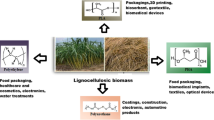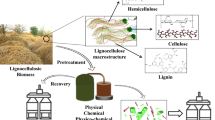Abstract
Peanut husks are agro-industrial waste and represent about 20 wt% of the peanut harvest. This waste product was subjected to fast pyrolysis in a pyroprobe reactor coupled with GC/MS at temperatures ranging from 350 to 600 °C to maximize levoglucosan production. Prior to pyrolysis, the biomass was washed with acetic acid (10 wt%) to remove the alkali and alkaline earth metals. Levoglucosan production from pretreated biomass increased for all the temperatures studied. However, the best result was observed at 550 °C. At this temperature, 35 wt% of produced levoglucosan was found in the volatile fraction, representing around a nine-fold increase in levoglucosan production compared to the untreated biomass. These results may be due to the removal of the alkali and alkaline earth metals or the morphological changes observed in the biomass via SEM. While the yields of undesirable compounds derived from lignin that interfere with levoglucosan purification and its applications (phenol, guaiacol, syringol and catechol) decreased as the pyrolysis temperature increased, the yields of other compounds (vanillin, eugenol, cresol, 4-methylcyclohexanone, furfural and acetaldehyde) increased. Our results confirm that pretreated peanut husks have great potential in levoglucosan production via fast pyrolysis.
Graphic Abstract











Similar content being viewed by others
References
Sarkar, N., Ghosh, S.K., Bannerjee, S., Aikat, K.: Bioethanol production from agricultural wastes: an overview. Renew. Energy 37(1), 19–27 (2012). https://doi.org/10.1016/j.renene.2011.06.045
David, G.F., Justo, O.R., Perez, V.H., Garcia-Perez, M.: Thermochemical conversion of sugarcane bagasse by fast pyrolysis: high yield of levoglucosan production. J. Anal. Appl. Pyrol. 133, 246–253 (2018). https://doi.org/10.1016/j.jaap.2018.03.004
David, G.F., Perez, V.H., Rodriguez Justo, O., Garcia-Perez, M.: Effect of acid additives on sugarcane bagasse pyrolysis: production of high yields of sugars. Biores. Technol. 223, 74–83 (2017). https://doi.org/10.1016/j.biortech.2016.10.051
David, G.F., Ríos-Ríos, A.M., de Fátima, Â., Perez, V.H., Fernandes, S.A.: The use of p-sulfonic acid calix[4]arene as organocatalyst for pretreatment of sugarcane bagasse increased the production of levoglucosan. Ind. Crops Prod. 134, 382–387 (2019). https://doi.org/10.1016/j.indcrop.2019.02.034
Pecha, B., Arauzo, P., Garcia-Perez, M.: Impact of combined acid washing and acid impregnation on the pyrolysis of Douglas fir wood. J. Anal. Appl. Pyrol. 114, 127–137 (2015). https://doi.org/10.1016/j.jaap.2015.05.014
Chan, J.K.S., Duff, S.J.B.: Methods for mitigation of bio-oil extract toxicity. Biores. Technol. 101(10), 3755–3759 (2010). https://doi.org/10.1016/j.biortech.2009.12.054
Layton, D.S., Ajjarapu, A., Choi, D.W., Jarboe, L.R.: Engineering ethanologenic Escherichia coli for levoglucosan utilization. Biores. Technol. 102(17), 8318–8322 (2011). https://doi.org/10.1016/j.biortech.2011.06.011
Lian, J., Chen, S., Zhou, S., Wang, Z., O’Fallon, J., Li, C.-Z., Garcia-Perez, M.: Separation, hydrolysis and fermentation of pyrolytic sugars to produce ethanol and lipids. Biores. Technol. 101(24), 9688–9699 (2010). https://doi.org/10.1016/j.biortech.2010.07.071
Lian, J., Garcia-Perez, M., Chen, S.: Fermentation of levoglucosan with oleaginous yeasts for lipid production. Biores. Technol. 133, 183–189 (2013). https://doi.org/10.1016/j.biortech.2013.01.031
Zhuang, X.L., Zhang, H.X., Yang, J.Z., Qi, H.Y.: Preparation of levoglucosan by pyrolysis of cellulose and its citric acid fermentation. Biores. Technol. 79(1), 63–66 (2001). https://doi.org/10.1016/S0960-8524(01)00023-2
Fahmi, R., Bridgwater, A.V., Darvell, L.I., Jones, J.M., Yates, N., Thain, S., Donnison, I.S.: The effect of alkali metals on combustion and pyrolysis of Lolium and Festuca grasses, switchgrass and willow. Fuel 86(10), 1560–1569 (2007). https://doi.org/10.1016/j.fuel.2006.11.030
Yang, Z., Liu, X., Yang, Z., Zhuang, G., Bai, Z., Zhang, H., Guo, Y.: Preparation and formation mechanism of levoglucosan from starch using a tubular furnace pyrolysis reactor. J. Anal. Appl. Pyrol. 102, 83–88 (2013). https://doi.org/10.1016/j.jaap.2013.03.012
Wang, J., Wei, Q., Zheng, J., Zhu, M.: Effect of pyrolysis conditions on levoglucosan yield from cotton straw and optimization of levoglucosan extraction from bio-oil. J. Anal. Appl. Pyrol. 122, 294–303 (2016). https://doi.org/10.1016/j.jaap.2016.09.013
Rizhikovs, J., Brazdausks, P., Dobele, G., Jurkjane, V., Paze, A., Meile, K., Puke, M.: Pretreated hemp shives: possibilities of conversion into levoglucosan and levoglucosenone. Ind. Crops Prod. 139, 111520 (2019). https://doi.org/10.1016/j.indcrop.2019.111520
Sun, T., Li, Z., Zhang, Z., Wang, Z., Yang, S., Yang, Y., Wang, X., Liu, S., Zhang, Q., Lei, T.: Fast corn stalk pyrolysis and the influence of catalysts on product distribution. Biores. Technol. 301, 122739 (2020). https://doi.org/10.1016/j.biortech.2020.122739
Kawamoto, H., Morisaki, H., Saka, S.: Secondary decomposition of levoglucosan in pyrolytic production from cellulosic biomass. J. Anal. Appl. Pyrol. 85(1), 247–251 (2009). https://doi.org/10.1016/j.jaap.2008.08.009
Garcia-Perez, M., Wang, S., Shen, J., Rhodes, M., Lee, W.J., Li, C.-Z.: Effects of temperature on the formation of lignin-derived oligomers during the fast pyrolysis of mallee woody biomass. Energy Fuels 22(3), 2022–2032 (2008). https://doi.org/10.1021/ef7007634
Tessini, C., Vega, M., Müller, N., Bustamante, L., von Baer, D., Berg, A., Mardones, C.: High performance thin layer chromatography determination of cellobiosan and levoglucosan in bio-oil obtained by fast pyrolysis of sawdust. J. Chromatogr. A 1218(24), 3811–3815 (2011). https://doi.org/10.1016/j.chroma.2011.04.037
Liaw, S.-S., Haber Perez, V., Zhou, S., Rodriguez-Justo, O., Garcia-Perez, M.: Py-GC/MS studies and principal component analysis to evaluate the impact of feedstock and temperature on the distribution of products during fast pyrolysis. J. Anal. Appl. Pyrol. 109, 140–151 (2014). https://doi.org/10.1016/j.jaap.2014.06.018
Zhou, S., Wang, Z., Liaw, S.-S., Li, C.-Z., Garcia-Perez, M.: Effect of sulfuric acid on the pyrolysis of Douglas fir and hybrid poplar wood: Py-GC/MS and TG studies. J. Anal. Appl. Pyrol. 104, 117–130 (2013). https://doi.org/10.1016/j.jaap.2013.08.013
Li, Q., Steele, P.H., Yu, F., Mitchell, B., Hassan, E.-B.M.: Pyrolytic spray increases levoglucosan production during fast pyrolysis. J. Anal. Appl. Pyrol. 100, 33–40 (2013). https://doi.org/10.1016/j.jaap.2012.11.013
Folgueras, M.B., Fernández, F.J., Ardila, C.R., Alonso, M., Lage, S.: Fast pyrolysis of Guadua angustifolia-Kunth. Energy Procedia 136, 60–65 (2017). https://doi.org/10.1016/j.egypro.2017.10.283
Ghorbannezhad, P., Kool, F., Rudi, H., Ceylan, S.: Sustainable production of value-added products from fast pyrolysis of palm shell residue in tandem micro-reactor and pilot plant. Renew. Energy 145, 663–670 (2020). https://doi.org/10.1016/j.renene.2019.06.063
Silveira-Junior, E.G., Perez, V.H., Justo, O.R., David, G.F., Simionatto, E., deOliveira, L.C.S.: Valorization of guava (Psidium guajava L.) seeds for levoglucosan production by fast pyrolysis. Cellulose (2020). https://doi.org/10.1007/s10570-020-03506-x
Gudka, B., Jones, J.M., Lea-Langton, A.R., Williams, A., Saddawi, A.: A review of the mitigation of deposition and emission problems during biomass combustion through washing pre-treatment. J. Energy Inst. 89(2), 159–171 (2016). https://doi.org/10.1016/j.joei.2015.02.007
Deng, L., Zhang, T., Che, D.: Effect of water washing on fuel properties, pyrolysis and combustion characteristics, and ash fusibility of biomass. Fuel Process. Technol. 106, 712–720 (2013). https://doi.org/10.1016/j.fuproc.2012.10.006
Hu, Y., Wang, S., Wang, Q., He, Z., Lin, X., Xu, S., Ji, H., Li, Y.: Effect of different pretreatments on the thermal degradation of seaweed biomass. Proc. Combust. Inst. 36(2), 2271–2281 (2017). https://doi.org/10.1016/j.proci.2016.08.086
SilveiraJunior, E.G., Simionatto, E., Perez, V.H., Justo, O.R., Zárate, N.A.H., Vieira, Md.C.: Potential of virginia-type peanut (Arachis hypogaea L.) as feedstock for biodiesel production. Ind. Crops Prod. 89, 448–454 (2016). https://doi.org/10.1016/j.indcrop.2016.04.050
Liu, R., Liu, G., Yousaf, B., Abbas, Q.: Operating conditions-induced changes in product yield and characteristics during thermal-conversion of peanut shell to biochar in relation to economic analysis. J. Clean. Prod. 193, 479–490 (2018). https://doi.org/10.1016/j.jclepro.2018.05.034
Wan, S., Zheng, N., Zhang, J., Wang, J.: Role of neutral extractives and inherent active minerals in pyrolysis of agricultural crop residues and bio-oil formations. Biomass Bioenergy 122, 53–62 (2019). https://doi.org/10.1016/j.biombioe.2019.01.010
Fermanelli, C.S., Córdoba, A., Pierella, L.B., Saux, C.: Pyrolysis and copyrolysis of three lignocellulosic biomass residues from the agro-food industry: a comparative study. Waste Manag. 102, 362–370 (2020). https://doi.org/10.1016/j.wasman.2019.10.057
Gurevich Messina, L.I., Bonelli, P.R., Cukierman, A.L.: Effect of acid pretreatment and process temperature on characteristics and yields of pyrolysis products of peanut shells. Renew. Energy 114, 697–707 (2017). https://doi.org/10.1016/j.renene.2017.07.065
CONAB, C.N.d.A.: Acompanhamento da Safra Brasileira-Grãos. In: SAFRA 2019/20-N. 4-Quarto levantamento, vol. V7, CONAB (Companhia Nacional de Abastecimento), Brasilia (2020)
USDA, U.S.D.o.A.R.S.: World Agricultural Production. https://apps.fas.usda.gov/psdonline/circulars/production.pdf (2019). Accessed 07 Jan 2020
AOCS, A.O.C.S.: Official methods and recommended practices of the AOCS. In: American Oil Chemists’ Society, Champaign (1998)
Barber, S.T., Yin, J., Draper, K., Trabold, T.A.: Closing nutrient cycles with biochar—from filtration to fertilizer. J. Clean. Prod. 197, 1597–1606 (2018). https://doi.org/10.1016/j.jclepro.2018.06.136
Prasai, T.P., Walsh, K.B., Bhattarai, S.P., Midmore, D.J., Van, T.T.H., Moore, R.J., Stanley, D.: Biochar, bentonite and zeolite supplemented feeding of layer chickens alters intestinal microbiota and reduces campylobacter load. PLoS ONE 11(4), e0154061 (2016). https://doi.org/10.1371/journal.pone.0154061
Li, R., Zhang, Y., Deng, H., Zhang, Z., Wang, J.J., Shaheen, S.M., Xiao, R., Rinklebe, J., Xi, B., He, X., Du, J.: Removing tetracycline and Hg(II) with ball-milled magnetic nanobiochar and its potential on polluted irrigation water reclamation. J. Hazard. Mater. 384, 121095 (2020). https://doi.org/10.1016/j.jhazmat.2019.121095
Sato, M.K., deLima, H.V., NoronhaCosta, A., Rodrigues, S., Mooney, S.J., Clarke, M., SilvaPedroso, A.J., deFreitasMaia, C.M.B.: Biochar as a sustainable alternative to açaí waste disposal in Amazon Brazil. Process Saf. Environ. Prot. 139, 36–46 (2020). https://doi.org/10.1016/j.psep.2020.04.001
Perez, V.H., daSilva, N.R.F., SilveiraJunior, E.G., Rocha, D.C., Justo, O.R., David, G.F., Roman, D.C.C., LacerdaJr, V.L., Garcia-Perez, M.: Integrated process of biomass thermochemical conversion to obtain pyrolytic sugars for biofuels and bioproducts. In: Ingle, A.P., Chandel, A.K., daSilva, S.S. (eds.) Lignocellulosic Biorefining Technologies, pp. 285–311. Wiley, Hoboken (2020)
Shafizadeh, F., Fu, Y.L.: Pyrolysis of cellulose. Carbohyd. Res. 29(1), 113–122 (1973). https://doi.org/10.1016/S0008-6215(00)82074-1
Jarboe, L.R., Wen, Z., Choi, D., Brown, R.C.: Hybrid thermochemical processing: fermentation of pyrolysis-derived bio-oil. Appl. Microbiol. Biotechnol. 91(6), 1519–1523 (2011). https://doi.org/10.1007/s00253-011-3495-9
Zhou, S., Mourant, D., Lievens, C., Wang, Y., Li, C.-Z., Garcia-Perez, M.: Effect of sulfuric acid concentration on the yield and properties of the bio-oils obtained from the auger and fast pyrolysis of Douglas Fir. Fuel 104, 536–546 (2013). https://doi.org/10.1016/j.fuel.2012.06.010
Dobele, G., Dizhbite, T., Rossinskaja, G., Telysheva, G., Meier, D., Radtke, S., Faix, O.: Pre-treatment of biomass with phosphoric acid prior to fast pyrolysis: a promising method for obtaining 1,6-anhydrosaccharides in high yields. J. Anal. Appl. Pyrol. 68–69, 197–211 (2003). https://doi.org/10.1016/S0165-2370(03)00063-9
Kumagai, S., Matsuno, R., Grause, G., Kameda, T., Yoshioka, T.: Enhancement of bio-oil production via pyrolysis of wood biomass by pretreatment with H2SO4. Biores. Technol. 178, 76–82 (2015). https://doi.org/10.1016/j.biortech.2014.09.146
Persson, H., Kantarelis, E., Evangelopoulos, P., Yang, W.: Wood-derived acid leaching of biomass for enhanced production of sugars and sugar derivatives during pyrolysis: influence of acidity and treatment time. J. Anal. Appl. Pyrol. 127, 329–334 (2017). https://doi.org/10.1016/j.jaap.2017.07.018
Montoya, J.I., Chejne-Janna, F., Garcia-Pérez, M.: Fast pyrolysis of biomass: a review of relevant aspects: part I: parametric study. DYNA 82, 239–248 (2015)
Jakab, E.: Chapter 3—Analytical techniques as a tool to understand the reaction mechanism. In: Pandey, A., Bhaskar, T., Stöcker, M., Sukumaran, R.K. (eds.) Recent Advances in Thermo-Chemical Conversion of Biomass, pp. 75–108. Elsevier, Boston (2015)
Liaw, S.-S., Justo, O.R., Perez, V.H., Zhou, S., Garcia-Perez, M.: Ozonation of pyrolytic aqueous phase: Changes in the content of phenolic compounds and color. Chem. Eng. Technol. 39(10), 1828–1834 (2016). https://doi.org/10.1002/ceat.201500420
Acknowledgements
We are grateful to the following Brazilian agencies for financial support: Foundation Carlos Chagas Filho Research Support from the State of Rio de Janeiro (FAPERJ—Grant No.: E-26/202.457/2019 and E-26/202.688/2019), Coordination for the Improvement of Higher-Level Personnel-Brazil (CAPES Finance Code 001), The National Council for Scientific and Technological Development (CNPq—Process no. 433235/2016-0), The Grants Program of the Estácio de Sá University for Research Productivity and Foundation Research Support from the State of Minas Gerais (FAPEMIG). We also thank Professor Lincoln Carlos Silva de Oliveira, from the Chemistry Institute at UFMS (Brazil), for his support in the thermogravimetric analysis.
Author information
Authors and Affiliations
Corresponding author
Ethics declarations
Conflict of interest
The authors declare no conflict of interest.
Additional information
Publisher's Note
Springer Nature remains neutral with regard to jurisdictional claims in published maps and institutional affiliations.
Supplementary Information
Below is the link to the electronic supplementary material.
Rights and permissions
About this article
Cite this article
Silveira Junior, E.G., da Silva, N.R.F., Perez, V.H. et al. Fast Pyrolysis of Peanut Husk Agroindustrial Waste: Intensification of Anhydro Sugar (Levoglucosan) Production. Waste Biomass Valor 12, 5573–5585 (2021). https://doi.org/10.1007/s12649-021-01403-3
Received:
Accepted:
Published:
Issue Date:
DOI: https://doi.org/10.1007/s12649-021-01403-3




